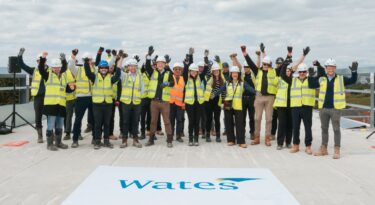Supporting the
One year into the pandemic, we can assess more clearly what its long-term implications on our lives might be.”

Andrew Barraclough
Group Design Director, Wates Construction
Society is in a constant state of evolution and probably more so in the last 30 years than at any point in human history. The advent of the personal computer and more importantly, the Internet, has changed how we work, how we communicate and even how we think
The technological revolution was already taking us to new places and creating previously unconsidered opportunities, but the pandemic has been the great accelerator, supercharging us all headlong into a digital future.
Embracing the opportunities that technology offers is no longer optional but a necessity. That makes this an incredibly exciting moment for the construction industry, particularly when seen through the prism of the public sector and the panacea of delivering projects more efficiently, of higher quality and that are more sustainable.
Offsite ambitions
At the heart of these aspirations will be pre-manufactured value (PMV) increasingly seen as the Holy Grail in public sector procurement, and an area where digital innovation will be absolutely critical.
To really reap the benefits of offsite then we must aspire to a digital end-to-end process. This means the data, information and geometry that is established at the beginning of the design process, remains available and relevant through the delivery and the life of the asset. This is something that is currently not the case.
When we look at offsite manufacturing, the data from the original modelling is often not usable so that information is then reproduced in a different format, creating significant inefficiencies all along the process.
This conundrum of interoperability is one that is slowly being addressed by the software developers but until data produced in one format can be reproduced and read without losing any of its fidelity, the dream of a seamless end-to-end approach will remain just that.
Collect data to reduce carbon
Where technology and the advent of a more digital mindset can be completely transformative is in addressing the carbon challenge. Here, the public sector has to be in the vanguard if we are going to successfully tackle the greatest crisis facing us all.
Increasingly we are hearing the right noises coming from the industry about this issue, but an often-heard refrain is that the necessary data doesn’t exist that will allow us to benchmark, analyse and improve.
However, we are starting to see a much more robust attitude to the importance of data, for example, on projects such as the Sandwell Aquatics Centre. Here we will have a more comprehensive data set on the carbon footprint of the project delivery than we have ever had before.
But this is only part of the solution. Through embracing digital across the entire lifecycle of a project we can also begin to develop more digital twins for our built projects, something that will be hugely important in meeting future carbon reduction targets for the whole life of a building.
In its purest form, a digital twin is a complete digital replica of a physical model and means that you can control all aspects of a built asset via a laptop or phone. You can control functions such as heating, environmental controls, lighting and security but more importantly, it means you can control and measure outputs, providing a far greater understanding of operational carbon and energy.

PUBLIC SECTOR PLAYBOOK
Government guidance on sourcing and contracting public works projects and programmes
Creating a digital twin of an asset is a significant undertaking, but the benefits are becoming much clearer. While this is unlikely to become standard practice overnight, the recently published Construction Playbook will certainly help drive the public sector along this digital journey.
The Playbook examined 14 different policy areas and a key recommendation was that complex projects must produce a ‘should cost’ model as part of assessment using past project data, putting life cycle costs front and centre, rather than just capital build costs.
The Playbook also made a number of recommendations around embedding digital technologies and driving forward a standard approach to BIM, reinforcing a vision for public sector procurement with technology at its core.
The pandemic has brought much uncertainty and small amount of misery but it has also highlighted the wonderful opportunities that technology can provide it’s now upon us to act.




